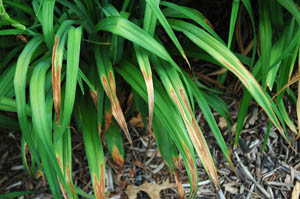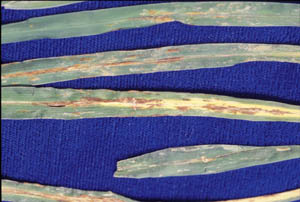Three Daylily Problems | |
|---|---|
| July 3, 2007 | |
|
Up until the year 2000, I never really concerned myself with diseases of daylilies. That is the year when daylily rust came to the United States and began moving around the country in and on mail-order plants. Sometimes, nurseries became unwelcome recipients of this disease as well. Now, there are three problems you might want to be aware of if you grow daylilies, but none is considered a major problem in Illinois. First, you should be familiar with environmental scorch of daylily. The image shows the bleached to tan areas on the leaves, especially at leaf tips or where leaves bend and are most exposed to the sun.  Hot, dry conditions promote leaf scorch. Watering the soil around daylilies on a weekly basis helps reduce the amount of scorch seen in the planting. Still, scorch is mostly an aesthetic problem, rarely causing any permanent growth problems. Hot, dry conditions promote leaf scorch. Watering the soil around daylilies on a weekly basis helps reduce the amount of scorch seen in the planting. Still, scorch is mostly an aesthetic problem, rarely causing any permanent growth problems. Daylily leaf streak, another very common occurrence in Illinois, is caused by a fungus, Aureobasidium microstictum. Look for yellow spots along leaf midveins, often starting from the tip and moving down the leaf. Small, reddish brown flecks or spots develop in this tissue. Daylily leaf streak may be confused with rust, but there are no pustules and no rusty spores to wipe off on your finger as with daylily rust. The attached image shows symptoms to expect.  Daylily cultivars vary in susceptibility to streak, so you may notice differences among varieties in your planting. In contrast, scorch probably occurs on all cultivars but is more intense on plants most exposed to sun and wind. The fungus causing daylily streak develops most quickly when temperatures are warm but not hot. You should be able to find daylily leaf streak in susceptible daylily beds now. It spreads by splashing spores or spores spread on animals (including us). To avoid spread of this disease, try to irrigate the soil rather than the foliage, and avoid working with plants when they are wet. Also, try to keep plants thinned to provide better air movement. There are fungicide options for daylily streak, if you choose that route. Compass is a product by Bayer that is registered for use on daylily for this disease. It contains trifloxystrobin and is a local penetrant, which means it is locally systemic and has limited movement in the plant. Thiophanate-methyl has a general ornamental label and has been shown to be effective at preventing infection by the leaf streak fungus. Daylily rust, caused by Puccinia hemerocallidis, is a fungal disease that appeared in the United States in 2000. It affects many popular varieties, including Stella D’Oro, Pardon Me, and Attribution. The good news is that this fungus cannot overwinter in Illinois. It must blow up from the southern states each year and thus has not become established as much of a threat to daylily growers in Illinois. Symptoms of rust begin as yellow-to-brown streaks on the leaves, much like daylily leaf streak. Aphid feeding can cause similar symptoms. The diagnostic difference is that rust also causes raised pustules on either surface of the leaf, but especially the underside. The yellow–orange to reddish brown pustules produce abundant spores that rub off when touched. Try rubbing the streaks with your finger or a piece of white paper. Rust leaves an orange streak. Resistant varieties may produce only yellow flecks. Daylily rust may kill leaves on susceptible plants. A comprehensive Web site discussing daylily rust—with images, research links, and management options—can be found at http://www.daylilyrust.org/. A Cornell University fact sheet on daylily rust is at http://plantclinic.cornell.edu/FactSheets/daylily%20rust/daylilyrust.htm. There are more photos on that page as well. | |
| Author: | Nancy Pataky |
